Posted on:
Jan 19th, 2014 By:
Anya99

Andrew Kemp and Ruggero Deodato at Twisted Fears.
Since Atlanta has become such a classic monster movie kind of city, ATLRetro presents the first in an ongoing new feature, CINEMA ATLRETRO MACABRE, featuring exclusive interviews with the masters and mistress of 20th century horror films. Our intrepid Retro Reviewer Andrew Kemp caught up with Ruggero Deodato, director of CANNIBAL HOLOCAUST (1980), last fall at the Twisted Fears convention. A special thanks also goes to Sandra Despirt, who translated the taped interview from Italian into English. Watch for our next interview with Barbara Steele soon.
By Andrew Kemp
Contributing Writer
We’re done talking, but the elderly gentleman holds me up for a second. He smiles and palms me a tiny wrapped piece of candy. He has, I swear, an actual twinkle in his eye. The gesture reminds me of something a movie grandpa might do, and the man—warm sweater, round glasses and with one last tuft of unruly white hair atop his head—certainly fits the role. I half-expect to find a golden Werther’s Original in my hand, but it turns out to be a fun-sized Milky Way. It’s not what I expect, but I can’t stop smiling at the thought that Ruggero Deodato just handed me a little morsel of something to eat.
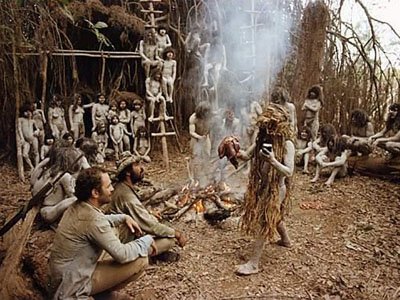
A scene from CANNIBAL HOLOCAUST.
Moments earlier that kindly old man, speaking to me in Italian with a translator, expressed bewilderment at his place in cinema infamy. “What I find incredible is that when I ask young people what they find more disturbing—my movie, CANNIBAL HOLOCAUST or the film of the real beheading of an American in Iraq—and they reply CANNIBAL HOLOCAUST,” he says. “Incredible, very disturbing.” Over 30 years after Deodato’s cannibal opus, the director still appears surprised at the power of what he made, even though he remains to this day one of the few film directors forced to produce his actors in the flesh simply to prove to authorities that they were still alive. Clearly, there’s just something about his film that digs beneath the skin.
CANNIBAL HOLOCAUST (1980) is one of cinema’s great provocations. A late entry into the brief Italian subgenre of cannibal movies, the film is alternately credited with canonizing the genre or destroying it, or sometimes both in the same breath. The film concerns a documentary crew that traipses into the Amazon to acquire rare footage of a savage, stone-age tribe of locals who may or may not engage in cannibalism. The title, I guess, is a spoiler. Suffice to say that no good comes to the crew, or to pretty much anyone else, including some unfortunate animals butchered on camera. Unlike the crew “deaths” that fooled the Italian courts, the animal torture is regrettably unsimulated. In the past, Deodato has claimed he was only filming a fact of daily life for the local tribes, that animals were routinely slaughtered in such a way for food and materials, not simply for his cameras. (A similar argument has always been made by Francis Ford Coppola about the bull death that closes APOCALYPSE NOW [1979]). Still, if you plan to see the film, consider the state of your stomach.
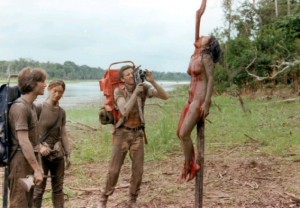
CANNIBAL HOLOCAUST.
Central to the movie’s ability to unsettle is the way Deodato frames the movie as a documentary and shoots it accordingly. Today, we know what that should look like, but nothing else quite like CANNIBAL HOLOCAUST existed at the time. Already established in cannibal cred after his 1977 LAST CANNIBAL WORLD [aka JUNGLE HOLOCAUST], Deodato found inspiration for his new technique much closer to home. “I had already made the film LAST CANNIBAL WORLD, which was a big success, especially in Japan. I ultimately decided to make CANNIBAL HOLOCAUST when terrorism [the Red Brigades] was almost a daily occurrence in Italy and my 7-year -old son asked me why there were so many horrific images on TV, casualties of these acts of terrorism. I thought to myself, hey, why is it that journalists can get away with it and I can’t? If I make a film, they cut it, so I decided to make this movie as a statement against the journalists and censorship.”
Although Italian media may have been the inspiration, Deodato’s film had a global impact because it tapped into the rise of media violence being beamed into televisions everywhere, including those seen in American living rooms every night during the Vietnam War, still a fresh wound in 1980. The brutality and realism of Deodato’s images rankled the public. It felt real, with none of those distancing effects that make movies so much fun to watch. A cult classic was born. CANNIBAL HOLOCAUST became so notorious that other directors had difficulty launching their own cannibal productions, and the bubble quickly burst. Deodato’s was a tough act to follow.
In recent years, Deodato is seen less as a rebel and more as a horror pioneer. The journalistic style Deodato developed in 1980 is today called by another name: found footage. Both fans and critics of the now-ubiquitous genre usually point to THE BLAIR WITCH PROJECT (1999) as the movie that brought shaky cameras and screaming amateur actors into the mainstream, but it’s hard to watch those mapless teens die in the Massachusetts woods, or to remember the internet buzz the accompanied the film, without noting that Deodato got there almost 20 years earlier. Don’t expect Deodato to be proud of all of his misbegotten children. “Unfortunately my idea has ruined movie-making to some extent because there are those that think all they need to have is a small camera and [to] start shooting without consideration for technique or storyline development.”
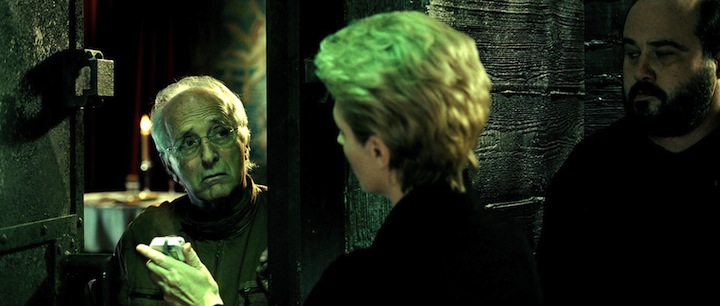
Deodato's cameo in HOSTEL, PART II
“When I see films that have truly been inspired by my CANNIBAL HOLOCAUST, I’m very happy, but not when they start putting in zombies, aliens and vampires,” he adds. “I hate that.”
Eli Roth is one Deodato admirer who not only shares the director’s taste for horror realism but also prefers to populate his pictures with sadistic human monsters rather than ghosts and ghoulies. After breaking out with the disease gorefest CABIN FEVER (2002), Roth became a spiritual successor to Deodato with his HOSTEL series, replacing clueless journalists with clueless American teens whose condescension to Europe and lust for booze and sex make them prey for sinister millionaires willing to pay big bucks to kill. Roth wears his influences on his sleeve, adding a wink to this in HOSTEL PART II (2007) by casting Deodato as a cultured cannibal in one of the film’s more memorable gross-outs. Roth’s latest effort, THE GREEN INFERNO (2013), takes another step in Deodato’s direction by reigniting the cannibal drama. In Roth’s film, again it’s the naïve outsiders who are torn apart by the natives they were hoping to protect. “Thirty-three years have passed and I’m still being imitated,” Deodato says. “Eli Roth is a friend of mine so at the end of his movie he did an homage to me by saying in the credits – To Ruggero.”

GREEN INFERNO.
The warmth that Deodato has for Roth doesn’t extend much further, it seems. I asked him about the current state of horror, how nobody seems to be terrorizing and disturbing audiences quite the way he did. “LAST CANNIBAL WORLD was filmed in the black jungle of Malaysia,” he notes. “For CANNIBAL HOLOCAUST, I was filming in the middle of the Amazon with indigenous tribes. Back in those days, people still didn’t know about a lot of things so when you came across a tribe in the middle of the jungle that was something. Now people travel everywhere. People were more easily shocked. It is much more difficult to do so now.”
Later, sitting on a panel with other Italian horror cinema legends Lamberto Bava and Barbara Steele, Deodato reminds me once more of a kindly old gentleman. When asked about horror cinema, he confesses that he doesn’t much like the genre anymore, noting his preference for dramas and romances. I think back on the story of the “murdered” actors he had to produce in court, and recall that even after the actors appeared, not all of the charges were dropped. Such was the impact of Deodato’s gore that to be fully cleared, the director first had to first demonstrate to court officials exactly how he had accomplished a signature, grotesque impalement with special effects. I think the prosecutor in question just wanted to get that particularly nasty bit out of his head.
Andrew Kemp is a screenwriter and game designer who started talking about movies in 1984 and got stuck that way. He can be seen around town wherever there are movies, cheap beer and little else.
Category: Features | Tags: Andrew Kemp, Apocalypse Now, Barbara Steele, blair witch project, canin fever, cannibal holocaust, cult movies, eli roth, Francis Ford Coppola, green inferno, horror, Hostel, Italian movies, jungle holocaust, lamberto bava, last cannibal world, ruggero deodato
Posted on:
Jul 15th, 2013 By:
Anya99
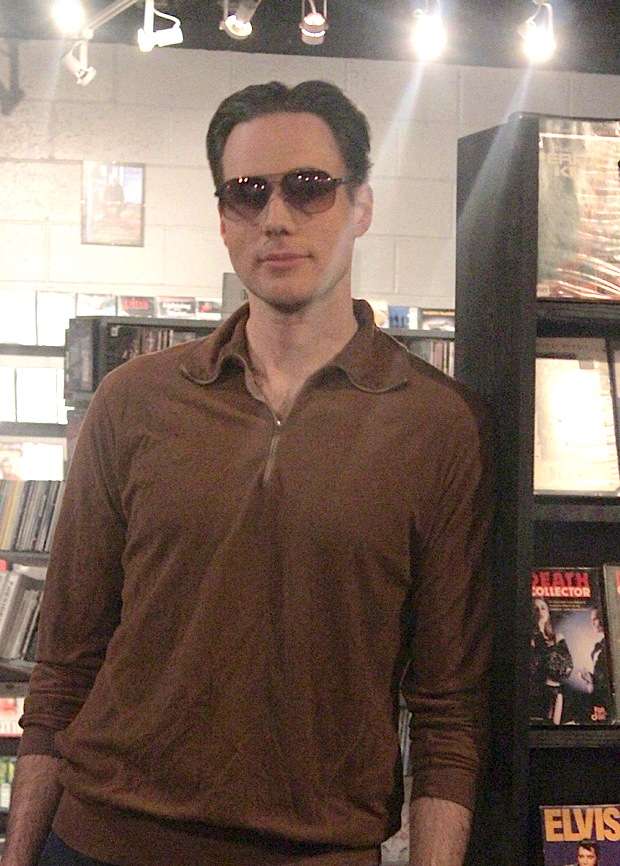
Mike Malloy. Photo credit: Andramada Brittian.
Video may have killed the radio star, or so that ’80s song goes, but it launched a lifelong passion for cult action movies in Kool Kat of the Week Mike Malloy. Now he’s paying homage to the format that revolutionized the way people accessed and watched movies from the late 1970s to the 1990s in the documentary series PLASTIC MOVIES REWOUND: THE STORY OF THE ’80S HOME VIDEO BOOM, for which he is seeking funding through a Kickstarter campaign. The timing couldn’t be more perfect with VHS tapes, like 33rpm LPs, enjoying a renaissance among collectors, both old and new.
From his slicked-back hair to his Retro bowling shirts, Mike looks like he ought to be playing the stand-up bass in a rockabilly band. Instead he’s devoted himself to “playing” tribute to a side of cinema that often doesn’t get a lot of love from mainstream critics. At age 19, he signed his first book contract to write the first published biography of Spaghetti Western star Lee Van Cleef (for McFarland & Co.) Since then, he went on to write articles for a wide spectrum of national film magazines, served as managing editor of fan favorite Cult Movies Magazine, has spoken about movie topics at universities, ghost-wrote several fim books, and served on the selection committee of the 2006 Atlanta Film Festival.
In the past few years, Mike has moved increasingly both in front of and behind the camera. He has acted in more than 25 features and shorts. He co-produced the Western THE SCARLET WORM (2011) and directed the short, LOOK OUT! IT’S GOING TO BLOW! (2006), which won the award for best comedy short at MicroCineFest in Baltimore. But he’s garnered the most acclaim, both national and international, for EUROCRIME! THE ITALIAN COP AND GANGSTER FILMS THAT RULED THE ’70s, a kickass documentary homage to that B-movie subgenre which he wrote, directed, edited and produced.
 ATLRetro caught up with Mike recently to find out more about how home videos fired his fascination with film, his unique vision for PLASTIC MOVIES REWOUND, some really cool incentives he’s lined up for his Kickstarter campaign which collectors will love and what’s up next for Georgia’s Renaissance man of cult action cinema.
ATLRetro caught up with Mike recently to find out more about how home videos fired his fascination with film, his unique vision for PLASTIC MOVIES REWOUND, some really cool incentives he’s lined up for his Kickstarter campaign which collectors will love and what’s up next for Georgia’s Renaissance man of cult action cinema.
Having written Lee Van Cleef‘s first published biography at age 19, you’ve obviously been into rare cult and B movies since an early age. What triggered your passion for the less reputable side of cinema and why does it appeal to you so much?
I’m a rare guy who’s deep into cult and genre cinema without caring much for horror or anything fantastic. For me, it’s all about a desperate Warren Oates shooting it out in Mexico. Or Lee Marvin with a submachine gun. For some reason, I’m just drawn to gritty tough-guy cinema – which is not necessarily the same thing as action cinema.
How did the home video revolution influence you personally? Having been born in 1976, you can’t really remember the pre-video days, I’d guess, but it must have afforded you access to a whole spectrum of these movies which otherwise would have been hard to track down and see.
And I even missed most of the ’80s video boom, because my parents, in 1990, were the last on the block to get a VCR. But in 1994, I made up for lost time. I had a college girlfriend who had an off-campus apartment, and while she was at work, she didn’t like the idea of me being on campus, potentially fraternizing with other young ladies. So before each shift, she would take me by the local mom-and-pop vid store and rent me 8 hours’ worth of Bronson, Van Cleef, Carradine, etc. That kept me safely in her apartment, and it put me on the cinema path I’m on.
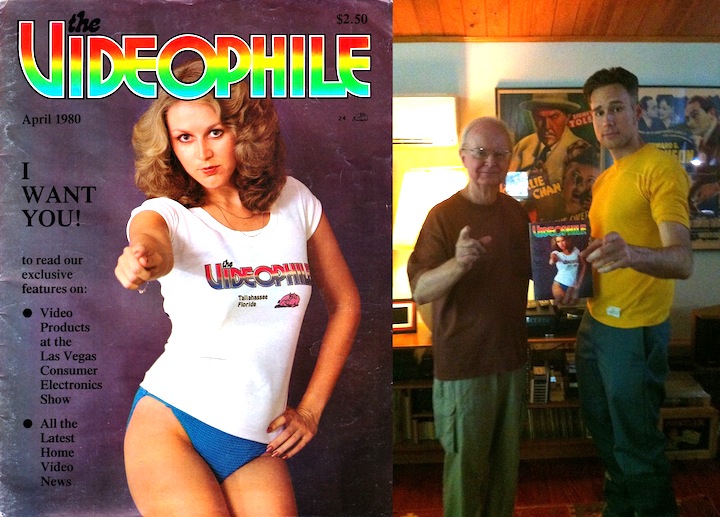
Videophile Magazine; Jim Lowe and Mike Malloy on the set of PLASTIC MOVIES REWOUND.
In Atlanta, Videodrome seems to be the last independent rental retailer still in business and it’s even hard to find a Blockbuster left. And of course, they now just stock DVDs. Now you can order up a movie online and watch it instantly. Do you think we’ve lost something by no longer going in to browse, and was there a particular video store that became your home away from home?
One of our interviewees said something interesting: The mom-and-pop video store business model was based on customer DISsatisfaction. That is, you’d go in to rent CITIZEN KANE, it would be checked out, and you’d somehow end up leaving with SHRIEK OF THE MUTILATED (1974). Being forced to browse leads to an experimental attitude in movie watching. That’s a good thing.
VHS tapes can get damaged easily, the picture and sound quality can’t compare to a bluRay (or often even a regular DVD) and they rarely show a movie in widescreen. Why be nostalgic about them, and is it true that the VHS format, like LPs, is having a comeback?
VHS is experiencing a major comeback. There are about 20 little startup companies that have begun releasing movies to VHS again. A certain old horror VHS – of a film called DEMON QUEEN (1986) – sold recently on eBay for $750.00. VHS conventions are springing up all over the country.
I’ve always thought that the format is superior for horror films. If you watch THE TEXAS CHAIN SAW MASSACRE (1974) on a soft old VHS poorly transferred from a faded film print, that makes you feel as if you’re watching some underground snuff film obtained from a shady guy in a trench coat. Watch that same movie on a pristine Blu-Ray, and you don’t get that same grimy feeling.
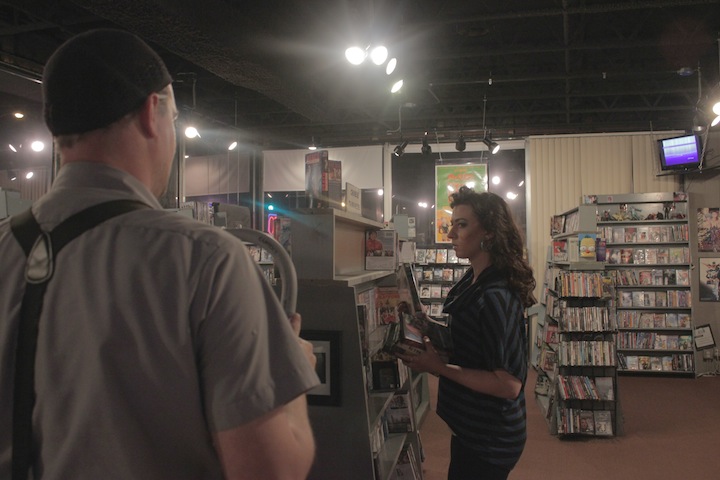
Michael Perkins films a scene at Videodrome, Atlanta's last great independent video store.
There have been other documentaries about home video, such as ADJUST YOUR TRACKING (2013) and REWIND THIS (2013). What will PLASTIC MOVIES REWOUND add to the topic that hasn’t been covered already?
PLASTIC MOVIES REWOUND will be a three-hour series, spanning six half-hour episodes. Those others just have a feature-length running time. So if mine isn’t the most definitive word on the subject, I’ve really screwed up. I’m sort of glad those docs exist as companion works, because it frees me up to explore some of the weirder corners of the phenomenon I find fascinating. Things like video vending machines and pizza-style home delivery of VHS tapes.
You’ve got a pretty interesting line-up of interviewees, not all of which are big names. Can you tell us about a few of them and how you went about selecting them.
Right, many of these people are very significant without being instantly recognizable. We have Mitch Lowe, the founder of Netflix (and later a CEO of Redbox). We have Jim Olenski, owner of what is considered to be the first-ever video store. We have Seth Willenson, a Vice President at RCA who oversaw their failed video disc format. That’s just several off the top of my head. They all have that level of significance. And we interviewed a bunch of cult filmmakers, because working at the cheap extreme of the video boom was where some of the craziest stories were. Further, we were glad – er, glad/sad – to have been able to document a closing video store in Toronto during its final month.
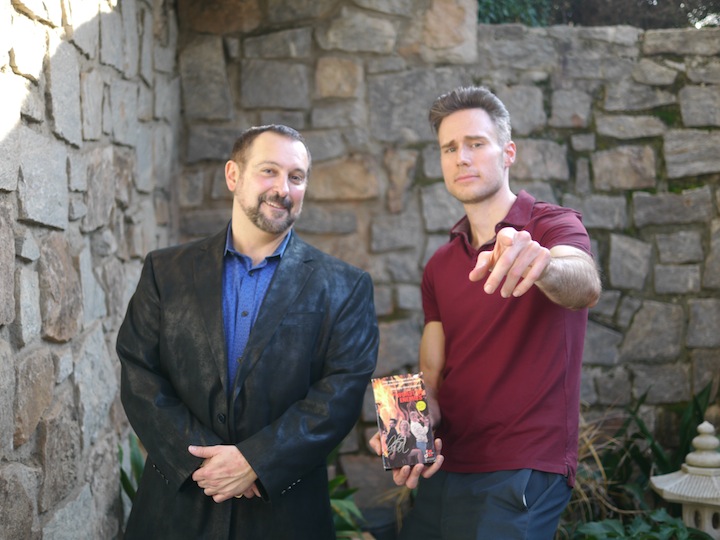
Gary Abdo and Mike Malloy. Photo credit: Jonathan Hickman.
Moviemakers, and artists of all ilk, have always seemingly been ripped off by others who pocket all the money. What distinguishes the video era in that regard, and are there any lessons filmmakers can apply to the current wild west of digital camerawork and online distribution?
I think the potential for ripping off artists is greater when an industry is in upheaval, when the rules and the financial models are unclear. And you’re right, VOD and streaming have caused the same type of upheaval that the videocassette did in its day. So I love all the anecdotes we captured of swindled ’80s filmmakers fighting back against their underhanded distributors. And I hope today’s filmmakers realize that distributors are now becoming largely unnecessary at all. For instance, I hope Vimeo OnDemand – with its 90-10 split in favor of the filmmaker – is a total game changer.
You obviously went into this project with a lot of background, but did you find out any big surprises or delightful unexpected moments during your interviews/research?
I went into the project feeling proud that I was going to cover not only VHS and Beta, but all the failed video formats – like Cartrivision, Selectavision (CED) and V-Cord II. Turns out, they were just the tip of the iceberg. I now probably have about 15 different also-ran video formats I can touch on.
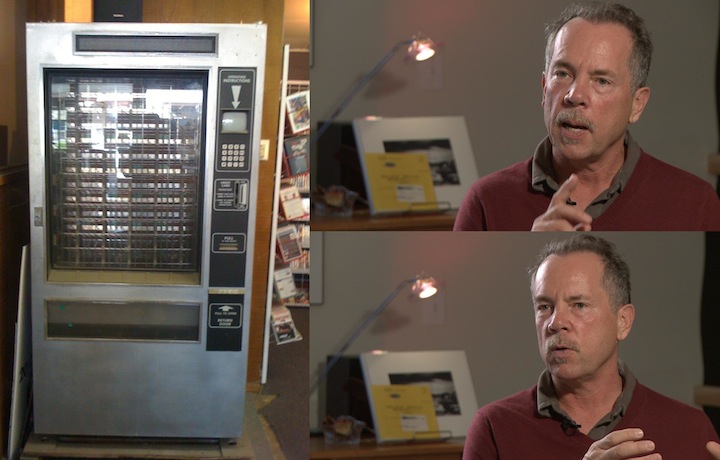
Left to right: a video vending machine; Mitch Lowe, founder of Netflix.
How different would the world be today if Cartrivision had caught on instead of VHS?
Well, Cartrivision was an early attempt at rights management for movies. The Cartrivision rental tapes couldn’t be rewound at home; that could only be done at Sears, where you rented them. It limited you to one viewing per rental. So it would’ve started the concept of video rentals off on a very different attitude and philosophy. I think part of the reason the ’80s home video phenomenon was such a boom was the freedom associated with it – you could rent a movie of your choosing and watch it at a time of your choosing. You could watch it a number of times before returning. Hell, you could use your rewind button to watch a jugsy shower scene over and over.
Tell us about the Kickstarter campaign. How’s it going and how are you going to use the monies raised to finalize the film?
Since ADJUST YOUR TRACKING and REWIND THIS both successfully kickstarted, I knew this would be an uphill battle. My only chance was to turn what is normally a beg-a-thon into a reward-a-thon. So I created a $75 level for the collectors where they could get so much more than just a copy of the documentary. The very first expense I’ll cover, if I get successfully funded, will be an 8 terabyte hard drive. I really can’t cut another frame until I get it.
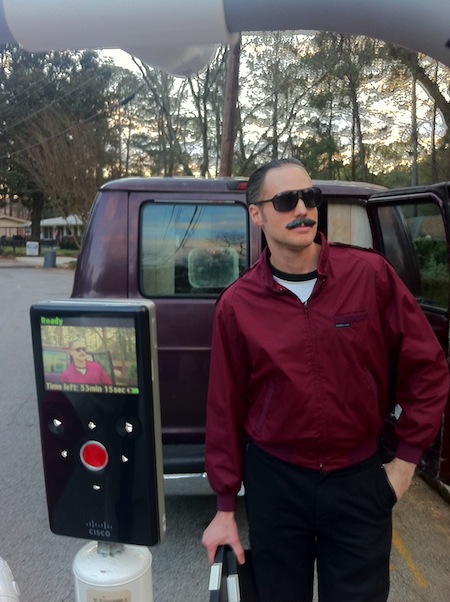
PLASTIC MOVIES REWOUND tells it like it was: Mike Malloy deals videos out of his van.
You’ve got some mighty cool incentives for donors, including actual vintage VHS cassettes. Tell us a little bit about them.
Not only have many of our filmmaker interviewees donated signed VHS and DVDs of their movies (to say nothing of rare, unused artwork and such), but a lot of these new startup VHS companies have also donated rewards. I’m feeling very supported.
Unlike your Italian-centric EUROCRIME documentary, you’re trying to involve Atlanta as much as possible in PLASTIC MOVIES REWOUND, aren’t you?
Local documentarian Michael Perkins (THE BOOKER) is my second-unit director, and Atlanta-based musician/engineer Matthew Miklos is my primary composer. His ’80s synth sound is so authentic. An associate producer (Jonathan Hickman) and at least one interviewee (filmmaker Gary Abdo) are here too. Videodrome has been very cool about letting me shoot re-enactments in the store. I tried to document the closing of another Atlanta institution of the video-rental industry, but it didn’t work out.
Anything else on your plate right now or next as a writer, director, producer or actor?
Later this year, I’m acting in HOT LEAD, HARD FURY in Denver and BUBBA THE REDNECK WEREWOLF in Florida. I wish someone would cast me locally so my pay doesn’t keep getting eaten up by travel expenses!
Editor’s Note: All photos are courtesy of Mike Malloy and used with permission.
Category: Kool Kat of the Week | Tags: 1980s, Adjust Your Tracking, Atlanta Film Festival, b-movies, Beta, Bronson, Bubba the Redneck Werewolf, Cartrivision, CED, cult movies, David Carradine, Demon Queen, Django, Django Lives, Django Unchained, Eurocrime, exploitation, Franco Nero, Gary Abdo, home video, Hot Lead Hard Fury, italian cop and gangster movies, Jim Olenski, Joe D'Augustine, Jonathan Hickman, Kickstarter, Kool Kat, Kool Kat of the Week, Lee Marvin, Lee Van Cleef, Look out it's going to blow, Matthew Miklos, mcfarland and company, Michael Perkins, Mike Malloy, Mitch Lowe, Netflix, Plastic Movies Rewound, quentin tarantino, RCA, Redbox, Rewind this, Robert Yeoman, Sears, Selectavision, Seth Willenson, Shriek of the Mutilated, spaghetti Western, Texas Chain Saw Massacre, The Booker, The Scarlet Worm, Toronto, V-Cord II, V/H/S, video rental, Video Store, Videodrome, Vimeo On Demand, Warren Oates, wes Anderson, western
Posted on:
May 30th, 2013 By:
Anya99
 Blast-Off Burlesque’s TABOO-LA-LA presents PINK FLAMINGOS (1972); Dir. John Waters; Starring Divine, Mink Stole, David Lochary, Cookie Mueller, Edith Massey, Danny Mills and Mary Vivian Pearce; Saturday, June 1 pre-show entertainment starts @ 9:00 p.m.; Plaza Theatre; Ages 18+ only; Tickets $12; Trailer here.
Blast-Off Burlesque’s TABOO-LA-LA presents PINK FLAMINGOS (1972); Dir. John Waters; Starring Divine, Mink Stole, David Lochary, Cookie Mueller, Edith Massey, Danny Mills and Mary Vivian Pearce; Saturday, June 1 pre-show entertainment starts @ 9:00 p.m.; Plaza Theatre; Ages 18+ only; Tickets $12; Trailer here.
By Aleck Bennett
Contributing Writer
It’s time once again to push across the boundaries of good taste and delve head-first into the outré, the out-of-bounds and the delightfully wrong as Blast-Off Burlesque and the Plaza Theatre bring us another heaping helping of TABOO-LA-LA!
This is it. The film that put John Waters and Divine on the map. The film that made Baltimore famous. The filthiest film in the world. PINK FLAMINGOS.
It’s crude, it’s angry and it wants to rub you the wrong way. It wants to offend you. It wants to provoke you. It wants to push you face-down in the ugliness that lurks just under the surface of everything and laugh at you. It will poke you with a stick. And you don’t know where that stick’s been.
All that, and it’s hilarious to boot.
“I’m all dressed up, and I’m ready to fall in love!” – Divine / Babs Johnson
The entire film is centered on the fact that Divine (played by Divine, as only she could), who is living under the alias of “Babs Johnson,” has been named the Filthiest Person Alive. This angers her arch-nemeses, Connie and Raymond Marble (Mink Stole and David Lochary). The Marbles are running an entire criminal empire entirely dedicated to being filthy. They force their gay servant Channing to artificially inseminate kidnapped women. They then sell the babies to lesbian couples. Then, the money they make from their black market baby ring is used to push heroin to elementary school students and fund their chain of pornography shops. Meanwhile, Raymond has a nice sideline going in flashing unsuspecting females and then stealing their purses. Understandably, the Marbles think that they are more deserving of this major award, so they set out to destroy Divine and unwittingly start a war that can only end in the destruction of all life on this planet. Or at least the lives of a few people in the Maryland boondocks.

PINK FLAMINGOS' Egg Lady (Edith Massey).
PINK FLAMINGOS takes the unusual step of making its heroine someone who has no moral qualms with killing anybody or everybody who dares look at her the wrong way. Someone whose raison d’être is summed up in the quote “Kill everyone now! Condone first degree murder! Advocate cannibalism! Eat shit! Filth is my politics! Filth is my life!” Divine is not just an anti-heroine, but an anti-human. You are dared to root for her, and you acquiesce because you fear that she may hack you to pieces with an axe for not doing so.
From a sex scene in which a live chicken is crushed to death to an orgy of oral sex spurred on by licking furniture; from one woman’s insatiable love of eggs to an anal sphincter singing “Surfin’ Bird”; from a trailer fire to, yes, the actual on-screen consumption of dog shit…PINK FLAMINGOS is not for the weak of heart, stomach, mind or constitution.
This was John Waters’ third feature film after MONDO TRASHO and MULTIPLE MANIACS, and featured his much-beloved Dreamland Productions ensemble. To get a handle on the Dreamlanders’ retro-trash aesthetic, imagine the B-52’s if they’d joined the Manson Family. Driven largely by a lack of money and a surplus of a camp sense of flash, their thrift store style was cemented by the Baltimoreans’ shared memories of the city back when it was the hairdo capitol of the world, and their sensibility shaped by Waters’ fascination with those who live outside the law. The Dreamlanders’ performances are all perfect. They exist beyond criticism. There’s nothing natural about them, but there’s nothing natural about the characters either, so who are we to judge? And while it’s not Waters’ most technically proficient film, its raw and blunt stylistic approach is the only thing suitable to capture the intense taboo-shattering of the subject matter. Anything prettier would take away from the transgressive attitude on display. And, quite literally, you can’t polish a turd…

Divine archnemeses Connie and Raymond Marble (Mink Stole and David Lochary).
Did I just say “taboo-shattering?” Because that’s what TABOO-LA-LA is about. And as such, this film practically screams to be shown. Because as transgressive and deliberately offensive as this film is, it’s also unbelievably positive. Remember, this was a mere three years after the Stonewall riots, where drag queens, lesbians and poverty-stricken gay street kids were on the front line against armed squadrons representing a society that would rather beat them down. In the wake of this, John Waters dared to turn a drag queen named Divine into a larger-than-life symbol of rebellion against anyone who’d dare take away anything that she claimed as hers. And in becoming the Goddess of Bad Taste, Divine was almost saying, “so you think all of us outsiders—drag queens, lesbians and gay men—are disgusting? Let me show you what disgusting really is, you prigs.”
It’s not just a fist in the face of a world that deserves it. It’s a celebration.
And it’s a celebration that Blast-Off Burlesque and TABOO-LA-LA are fully prepared to bring off the screen and into your faces. Enjoy complimentary cocktails in the lobby starting at 9 p.m.! A titillating live stage show featuring Blast-Off Burlesque, Baby-Doll and Poly Sorbate! A Filthy Fashion Contest and Sexy Doggie-Doo Eating Contest with prizes provided by Libertine and Cherry Blossom Salon! A raffle for PINK FLAMINGOS artwork by Zteven! And then, AS IF THAT WASN’T ENOUGH, the movie itself! How can you NOT go? If you decide to go anywhere else, know that I and my gang of fellow filth fanatics will sneak into your home and lick your furniture so that it will reject you when you return.
Now, if you’ll excuse me, I’ve got some hard-boiled eggs to eat.
Aleck Bennett is a writer, blogger, pug warden, pop culture enthusiast, raconteur and bon vivant from the greater Atlanta area. Visit his blog atdoctorsardonicus.wordpress.com
Category: Retro Review | Tags: Aleck Bennett, Baby Doll, Blast-Off Burlesque, Cherry Blossom Salon, chicken, Cookie Mueller, cult classic, cult movies, Danny Mills, David Lochary, Divine, Dr Sardonicus, drag queen, dreamland productions, Edith Massey, filthy fashion, hard-boiled eggs, John Waters, Libertine, Mary Vivian Pearce, Mink Stole, mondo trasho, multiple maniacs, Pink Flamingos, Plaza Theatre, sexy doggie-doo eating contest, Stonewall riots, surfin bird, Taboo-La-La, Zteven
Posted on:
Apr 24th, 2013 By:
Anya99
 FLESH GORDON (1974); Dirs: Michael Benveniste, Howard Ziehm; Starring Jason Williams, Suzanne Fields; Cineprov Presents on Sunday April 284, 7:30 p.m.; The Plaza Theatre, Trailer here.
FLESH GORDON (1974); Dirs: Michael Benveniste, Howard Ziehm; Starring Jason Williams, Suzanne Fields; Cineprov Presents on Sunday April 284, 7:30 p.m.; The Plaza Theatre, Trailer here.
By Andrew Kemp
Contributing Writer
When is the last time you talked to your mother about porn?
Yeah, OK. That’s a weird question. Let’s back up for a little context.
This Friday, the Plaza begins a run of one of the weirdest relics of the 1970s, softcore porn spoof FLESH GORDON. If you’ve ever doubted the commitment and film credentials of the new Plaza ownership, it may be time to suspend your disbelief, because I honestly don’t know another theatre in the city brave enough to put a softcore title on the screen just because they can. And GORDON is more than just a silly porno. It’s a genuine oddity, a movie with a unique role in film history and a gateway into that bizarro time in the 20th century when it was cool to watch porn.
When film projectors were invented over 100 years ago, the first bulb wasn’t cool before people found a way to use it for porn. Many of the earliest films we know about were skin flicks and erotica, because, then-as-now, that’s where the money was. But porn was always an outsider in the entertainment business, buried and segregated by strict, sometimes-draconian interpretations of obscenity laws. Porn was the film industry’s dirty secret, the seedy cousin nobody wants to talk about.
An unusual and powerful combination of events radically reshaped the porn industry in the late 1960s and early 1970s. The Sexual Revolution of the 60s became a point of cultural pride for the many young people living through civil unrest, a way to fully distinguish themselves from the conservative generation of their parents. For some, freer sex equated to progress, and that notion led to some strange experiments in the name of moving forward. This shift in the culture caused a general relaxing of local and federal obscenity laws, which in turn opened the door for wider distribution of porno publications and, eventually, the opening of theaters exclusively and proudly devoted to pornographic films. All of those screens needed content, and a batch of eager filmmakers rushed into the new market, filmmakers with big ideas inspired by a larger trend of European art films which happened to be arriving on American shores at about the same time, sexy films like BLOW-UP (1966), PERSONA (1966) and the arthouse thrillers of Roman Polanski. Those films had blurred the line between smut and art in a way that seemed to point to a number of possibilities: if films with sex could be art, well, then sex films could be art, too!
 This resulted in an extremely brief, but intensely weird trend dubbed by some as “porno-chic.” The trend began in 1970 with Michael Benveniste’s MONA THE VIRGIN NYMPH, the first major narrative hardcore porno film, and the first porn movie to receive widespread release in America. The success of MONA brought more attention to porn, and within two years, the genre had its first real “masterpieces” and mainstream box office smashes with BEHIND THE GREEN DOOR (1972) and the phenomenon DEEP THROAT (1972). As if the world hadn’t gone topsy turvy enough, porn films became the talk of mainstream film critics and big-city intellectuals, and many felt as if they couldn’t keep up with the water cooler conversation unless they were up to date on the latest stag flicks. Some porn stars—most famously Marilyn Chambers—threatened to break out of porn and into Hollywood.
This resulted in an extremely brief, but intensely weird trend dubbed by some as “porno-chic.” The trend began in 1970 with Michael Benveniste’s MONA THE VIRGIN NYMPH, the first major narrative hardcore porno film, and the first porn movie to receive widespread release in America. The success of MONA brought more attention to porn, and within two years, the genre had its first real “masterpieces” and mainstream box office smashes with BEHIND THE GREEN DOOR (1972) and the phenomenon DEEP THROAT (1972). As if the world hadn’t gone topsy turvy enough, porn films became the talk of mainstream film critics and big-city intellectuals, and many felt as if they couldn’t keep up with the water cooler conversation unless they were up to date on the latest stag flicks. Some porn stars—most famously Marilyn Chambers—threatened to break out of porn and into Hollywood.
It was into this environment that FLESH GORDON arrived. FLESH was an attempt at a big, mainstream porn comedy, co-directed by the father of porno-chic himself, MONA director Benveniste, but by the time FLESH was released, the trend was already slinking back into the shadows. FLESH takes as its target the original FLASH GORDON serials of the 1930s (not the more-famous FLASH GORDON film, which came six years after its porno progenitor) and places its hero on the planet Porno Mongo, ruled by the evil Wang the Perverted. Flesh’s mission: to stop a sex ray that could turn all of Earth into sex fiends. (A similar story, it turns out, to 1968’s BARBARELLA.) To give you a window into the film’s sense of humor, when Flesh and his crew arrive on Porno Mongo, they are attacked by a large, throbbing monster. It’s called, of course, a Penisaurus.
 So it’s not high art, but FLESH GORDON is more of a pleasure for film fans than a pain. While we may look at porn parodies today as hopelessly cheap and shlocky, nobody told the FLESH GORDON crew that they weren’t making a real film. The movie has a goofy sense of humor that gets it through the creaky plot, and it features incredibly-cool and inventive special effects, including a series of stop-motion critters designed and executed by future industry legends like Mike Minor (STAR TREK: THE MOTION PICTURE [1979]) and one of the all-time great movie monster makers, Rick Baker. FLESH GORDON exists at that one narrow crossroads in film history where porno ambitions met mainstream talent, and it provides a glimpse into a different direction that American movies might have gone. Despite the tendency of porn to exploit its stars, there’s nothing mean-spirited in FLESH GORDON’s softcore spirit. The film is packed with nudity from end to end, but often feels more like admiration than exploitation, more Russ Meyer than Chuck Traynor.
So it’s not high art, but FLESH GORDON is more of a pleasure for film fans than a pain. While we may look at porn parodies today as hopelessly cheap and shlocky, nobody told the FLESH GORDON crew that they weren’t making a real film. The movie has a goofy sense of humor that gets it through the creaky plot, and it features incredibly-cool and inventive special effects, including a series of stop-motion critters designed and executed by future industry legends like Mike Minor (STAR TREK: THE MOTION PICTURE [1979]) and one of the all-time great movie monster makers, Rick Baker. FLESH GORDON exists at that one narrow crossroads in film history where porno ambitions met mainstream talent, and it provides a glimpse into a different direction that American movies might have gone. Despite the tendency of porn to exploit its stars, there’s nothing mean-spirited in FLESH GORDON’s softcore spirit. The film is packed with nudity from end to end, but often feels more like admiration than exploitation, more Russ Meyer than Chuck Traynor.
There’s some confusion as to the different versions of FLESH GORDON available to the public. For many years, the only version of the film available was a heavily-edited 72 minutes long, and rumors persisted of a longer hardcore cut. But when the restored, uncut version appeared years later, it remained softcore. (This uncut version is the one playing at the Plaza) Co-director Howard Ziehm has stated that there were hardcore scenes filmed, but that they were nabbed by police in an obscenity-law sting and have been permanently lost. This is probably for the best. Part of the fun of FLESH GORDON is the way that, despite its rampant nudity and bawdy sexuality, the film somehow retains its gee-whiz innocence. Penetration tends to ruin that illusion.
The moment of the mainstream porn film was basically gone by the time FLESH GORDON arrived, but the film’s legacy is still felt today. GORDON was the first porn spoof, and its success in, frankly, getting away with it blazed a trail for decades of porno spoofs that have become the most famous version of the form. If you’ve ever sat around wondering what the “porn name” of your favorite mainstream film would be, you owe a debt, however small, to FLESH GORDON. Sadly, today’s pornos have give up on the clever titles and funny rebranding in favor of just putting “parody” right in the name. I know it’s porn we’re talking about here, but come on. “Batman: The Porn Parody?” Where’s the fun in that?
So how did I wind up talking with my mother about porn? Well, I realized that Mom would have been in her 20s at the peak of porno-chic. Surely she knew about it. Was she aware it was going on? Did she *gasp* see DEEP THROAT? I approached the subject with some caution and, after some explaining, she agreed to answer my question. She looked me right in the eye and said, “Son, I don’t know what you’re talking about.”
Thank you, Mom. I wouldn’t have it any other way.
Andrew Kemp is a screenwriter and game writer who started talking about movies in 1984 and got stuck that way. He writes at www.thehollywoodprojects.com and hosts a bimonthly screening series of classic films at theaters around Atlanta.
Category: Retro Review | Tags: 1970s movies, 70s movies, Andrew Kemp, Barbarella, Behind the Green Door, Bizarro, blow-up, Chuck Traynor, cult movies, Deep Throat, edited, Flesh Gordon, Howard Ziehm, Jason Williams, Marilyn Chambers, Michael Benveniste, Mike Minor, Mona the Virgin Nymph, persona, Plaza Theatre, Porno Mongo, porno spoof, pornography, Rick Baker, Roman Polanski, Russ Meyer, sexual revolution, softcore, Suzanne Fields, uncut, Wang the Perverted
Posted on:
Apr 24th, 2013 By:
Anya99
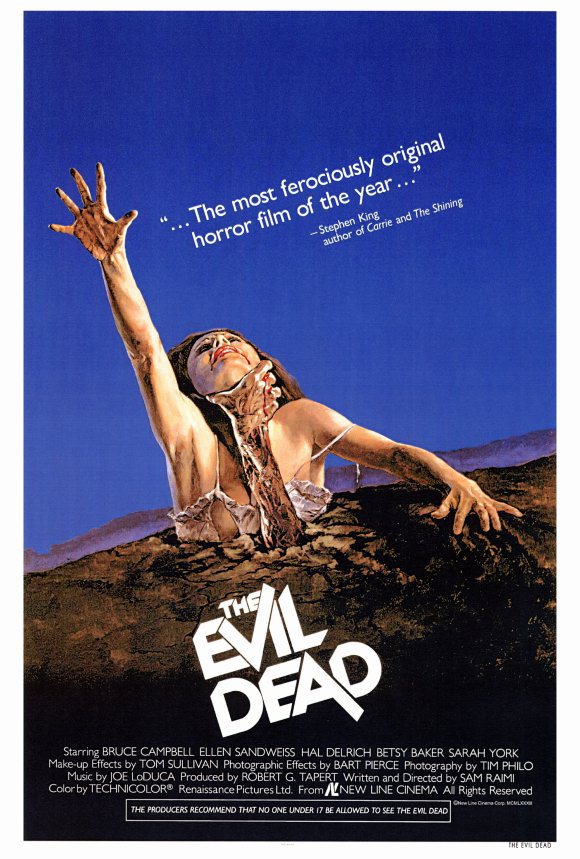
THE EVIL DEAD (1981); Dir. Sam Raimi; Starring Bruce Campbell, Ellen Sandweiss, Hal Delrich, Betsy Baker and Sarah York; Available on DVD and Blu-Ray from Anchor Bay Entertainment; Trailer here.
By Aleck Bennett
Contributing Writer
There’s such a hue and cry over the seemingly unending parade of remakes coming out of the Hollywood horror entertainment complex. It’s increasingly hard to approach one on its own terms without feeling like you’re betraying all that is good and true in this world. And when it comes to a beloved horror classic like Sam Raimi’s 1981 gorefest THE EVIL DEAD, the stakes are raised even higher.
But here’s the complication: THE EVIL DEAD has already been remade. Not once, but twice. The film’s plot was summarized and streamlined into the first quarter hour or so of 1987’s EVIL DEAD II, which was then subsequently summarized and streamlined into the opening segment of the series’ third film, 1992’s ARMY OF DARKNESS. Further complicating matters is the fact that THE EVIL DEAD is itself a remake. Raimi’s 1978 short film WITHIN THE WOODS was developed as a prototype horror film to draw investors, and it successfully led to Raimi raising the nearly $100,000 needed to develop a feature-length version of the short.
To be clear: THE EVIL DEAD is far from being some sacred, untouchable text. Not even Raimi sees it as being one, as he’s been futzing around with the same story since 1978. And even then it wasn’t that original an idea: though Raimi denies having seen the film prior to production, the storyline of THE EVIL DEAD is relatively close to that of the 1967-70 drive-in classic EQUINOX. Both involve scientists who have unwittingly opened a portal between this world and a demonic realm, a mysterious occult text and a handful of early-20s youths who visit the scientist’s cabin and wind up fighting off demons. It’s become such an archetypal setup that the “five kids in a cabin” trope is the basis for Joss Whedon and Drew Goddard’s ultimate meta horror-comedy, 2012’s THE CABIN IN THE WOODS.
That being said, how does Fede Alvarez’s 2013 version compare with the 1981 model? Let’s take a look.
 Both stories are superficially similar: a group of five kids in their 20s visit a remote cabin, wherein they stumble upon a mysterious tome, the NATURON DEMONTO, which contains passages intended to open a portal and summon demons to this realm. The spells are read aloud (in the original, played via a scientist’s tape recording; in the 2013 version, directly read from the book), and said demons are summoned. One by one, the five are picked off and controlled by the ancient evil called forth by the book.
Both stories are superficially similar: a group of five kids in their 20s visit a remote cabin, wherein they stumble upon a mysterious tome, the NATURON DEMONTO, which contains passages intended to open a portal and summon demons to this realm. The spells are read aloud (in the original, played via a scientist’s tape recording; in the 2013 version, directly read from the book), and said demons are summoned. One by one, the five are picked off and controlled by the ancient evil called forth by the book.
The first thing you’ll notice as different is the film’s immediate stylization. In the original, there’s a sense of everything being normal until we get to the cabin. In the remake, a pre-credit sequence of sacrifice casts a shadow over the proceedings, and to reflect that, there’s a consistent color desaturation which gives everything a sickly pallor and darkens the tone of the film. While I miss the gradual move away from “reality” that the original possesses, the point stands that the remake is, well, a remake. We know that bad stuff is about to go down and we know where it’s located (and if you didn’t know, the establishing sacrifice informs you).
The second thing is a deviation from the original’s storyline that affects the audience’s relationship with the characters: in the original, Bruce Campbell’s Ash is part of an ensemble and emerges as the film’s lead over time. In the remake, Jane Levy’s Mia (a recovering drug addict who has chosen the isolated cabin as a place to detox) is quickly established as the film’s focal character. By announcing right out of the gate who the film’s protagonist is, the sensation at the original’s outset that anybody could die at any time is somewhat lessened. We already know which character is established as the hero, but the question remains: how long will our hero last? Both films take their own path to establishing that question, but the original’s route creates more audience empathy. The remake’s approach results in a decrease in the sense of danger, meaning that no matter how many times the film pulls this rug out from under the viewer, the viewer is still inclined to think, “well, sure, but they can’t kill her; she’s the star!”
One thing in which both films succeed is the application of gore. Though budget kept the original’s prosthetic appliances looking like anything but prosthetic appliances, they made up for any shortcomings with a shocking amount of blood. And not just blood spurting from wounds, but from everywhere. And Raimi’s bravura direction pulled maximum shock out of every instance. Alvarez’s higher budget has resulted in more successful practical effects (he boasts that every effect was done on-set using practical effects, with CGI only used for touch-ups and more general uses such as manipulating the film’s color palette), and his insistence on not backing down from the original’s bloody reputation has resulted in this being quite probably the most gore-filled major studio film I’ve ever seen.
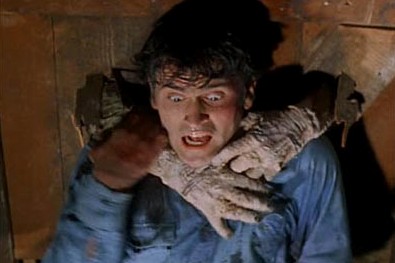
Bruce Campbell in the original EVIL DEAD. New Line Cinema, 1981. Available on DVD from Anchor Bay Entertainment.
Meanwhile, let me address something that I’ve seen crop up elsewhere in comparing the two: criticism that the 2013 film lacks the comedy of the original. The original film IS. NOT. FUNNY. Sure, there are one or two intentionally comedic moments in the first few minutes of the film as we follow our gang to the cabin. But the “splatstick” comedy that so many people associate with the EVIL DEAD franchise was something that popped up in the sequel, EVIL DEAD II. The first EVIL DEAD movie is every bit as serious about what’s going on as the remake. Got it? Good.
The main question, though, is this: does the film stand on its own two legs? I’d argue that it does, unequivocally. It does lack some of the sense of fun that the original had, particularly in its first half. But when the possession starts going and the blood starts flowing, it’s too easy to get caught up in the unbridled enthusiasm of the movie to not enjoy it from that point onward. Sure, there are plot holes and contrivances that might bring down any attempt to reason with the film, but in a movie like this, reason is the last thing you want to bring into the theater with you. The entire point of either film is to show what happens when reason can no longer be applied. And both films succeed and fail at showing that in probably equal amounts. And the remake might lack some of the bizarro flourishes that made Raimi’s film stand out that much more in that regard. But you can walk into this film not knowing of Bruce Campbell’s existence (I can’t imagine living such a life, but to each their own) and come away happy.
And I—knowing and loving the original, which I’ve probably owned more copies of in my life than any other film—walked away having enjoyed myself thoroughly. It’s a nice complement to the original, which it references enough to question whether it might be some kind of sequel: not only are the superficial elements in place (the cabin and the book, though the book has been redesigned due to copyright problems), but Ash’s 1973 Oldsmobile Delta 88 Royale is still present outside the cabin. (Nerds like myself might chime in with “…but Ash’s car was transported through the portal to ancient Sumeria in 1300 at the end of EVIL DEAD II!” To which I award you the coveted No-Prize, and direct you to the lobby to collect it.)
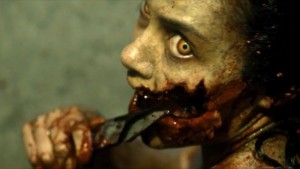
The new EVIL DEAD equals the original in blood and gore. Sony Pictures Entertainment, 2013.
It’s certainly the best of the recent crop of horror movie remakes. And while that might sound like damning with faint praise, it’s not intended to be. It works as both a celebration of the original and a successful horror film on its own. It doesn’t shy away from its visceral roots in order to deliver a PG-13 rating, or preemptively compromise itself so as to not invoke the MPAA’s wrath. Surprisingly, something this brutal made it through unscathed.
Five kids in a cabin. Deceptively easy to screw up. Thankfully, Fede Alvarez has kept things simple.
Blood simple.
Aleck Bennett is a writer, blogger, pug warden, pop culture enthusiast, raconteur and bon vivant from the greater Atlanta area. Visit his blog atdoctorsardonicus.wordpress.com
Category: Retro Review | Tags: 1981, 2013, Aleck Bennett, Anchor Bay Entertainment, Army of Darkness, Ash, Betsy Baker, Bruce Campbell, Cabin in the Woods, cult movies, Dr Sardonicus, Drew Goddard, Elizabeth Blackmore, Ellen Sandweiss, Equinox, Evil Dead, Evil Dead II, Fede Alvarez, Hal Delirch, horror movies, Jane Levy, Jessica Lucas, Joss Whedon, Lou Taylor Pucci, Naturon Demonto, Plaza Theatre, Sam Raimi, Sarah York, Shiloh Fernandez, Starlight Drive-In, Within the Woods
Posted on:
Jan 25th, 2013 By:
Anya99
 BARBARELLA (1968); Dir: Roger Vadim; Screenplay by Terry Southern; Based on a bande dessinee by Jean-Claude Forest; Starring Jane Fonda, John Phillip Law, Anita Pallenberg, David Hemmings, Milo O’Shea, Marcel Marceau; Plaza Theatre, Saturday, January 26 at 10:00pm; presented by BLAST-OFF BURLESQUE’S TABOO-LA-LA with live stage show before the screening including raffle of 10 8×10 signed photos of Fonda as Barbarella from Jane Fonda’s personal collection; Trailer here.
BARBARELLA (1968); Dir: Roger Vadim; Screenplay by Terry Southern; Based on a bande dessinee by Jean-Claude Forest; Starring Jane Fonda, John Phillip Law, Anita Pallenberg, David Hemmings, Milo O’Shea, Marcel Marceau; Plaza Theatre, Saturday, January 26 at 10:00pm; presented by BLAST-OFF BURLESQUE’S TABOO-LA-LA with live stage show before the screening including raffle of 10 8×10 signed photos of Fonda as Barbarella from Jane Fonda’s personal collection; Trailer here.
By Andrew Kemp
Contributing Writer
Today, I watched Jane Fonda narrowly escape death-by-orgasm in the Excessive Machine. How was your day?
Although I’d never seen BARBARELLA (1968), the infamous sci-fi sex romp produced by Dino de Laurentiis and directed by Roger Vadim, before today, I definitely knew about it. Almost everyone knows about it. BARBARELLA is a movie with more reputation than respect, a movie that, depending on who you ask, is either awful or awfully amazing. Just its name invokes a few key images—that amazing poster by Robert McGinnis; Jane Fonda’s buxom, uh, hair. I grew up in a post-STAR WARS world, when just the sight of a science-fiction ray blaster promised a particular brand of space fantasy and action, but combine aliens and thrills with the promise of a naked, beautiful woman? There’s not enough concrete on Earth to build a wall an adolescent boy can’t climb.
But I never made it over that wall. Yes, it’s true that young boys can sniff out nudie films like pigs root up truffles, but you guys have never met my mother. I once got a few short minutes of FLASH GORDON (1980) and its adventurous female costumes on the TV before she stomped into the room, feeling a psychic disturbance, I suppose, in her son’s mind. She played goalie effectively until around the time I entered high school, and by then I had found other ways to see boobs. And so, somehow, Barbarella and I had never met.
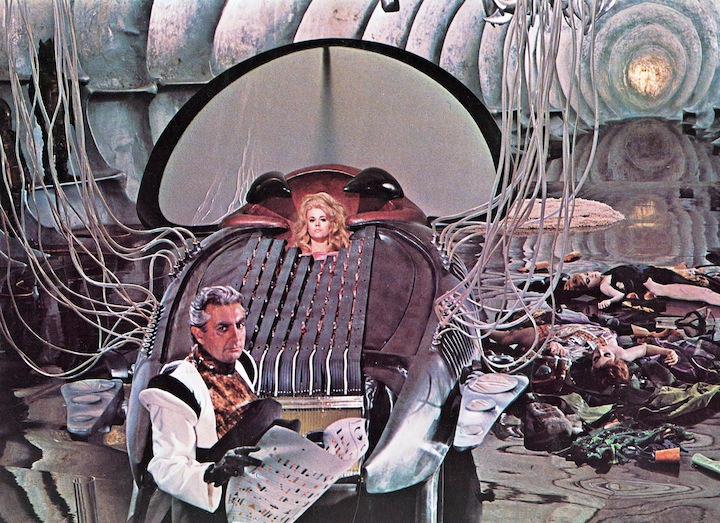
Durand Durand (Milo O'Shea_ tries to defeat Barbarella (Fonda) with death by orgasm. Paramount Pictures, 1968.
BARBARELLA was a famous flop at the box office, but its racy content, goofy cheerfulness about sex and outrageous set design—the spaceship is lined with shag carpet!—fit snugly with the mood of the late 1960s, at least with certain segments of the youth. The film quickly gained a cult infamy, especially as its star, Jane Fonda, transitioned into A-pictures and won an Oscar for the popular detective film, KLUTE (1971). There’s always been kind of a funny dividing line between mainstream film and exploitation, and it’s thrilling when some star gets a weekend pass to play on the other side, whether it’s Bruce Campbell showing up in SPIDER-MAN (2002) or Jane Fonda taking her clothes off. It was impossibly tantalizing to know that a major actress had once bared it all in a sex adventure, especially before home video, when the only way to see something like BARBARELLA was to catch a revival screening, and there weren’t nearly enough of those. Lack of availability helped grow the film’s legend, and it soon became trendy and cool to latch onto its camp appeal. Even by the early 1970s, a club named Barbarella’s existed in the UK, and it became a key location in the developing punk scene, hosting bands like The Sex Pistols and The Clash. One rising band that played frequently at the club even sampled clips and songs from the film into their music, tweaking the name of the film’s villain, Durand-Durand, into their own name, Duran Duran.
But it was the 1960s; everyone was taking their clothes off, right? There were plenty of sex movies in the world. What is it about BARBARELLA that keeps it going? “I just remember seeing that strip tease during the opening and being in love with the world,” says Max Shell, director of the undead-chicken cult movie THE DEVIL’S COCK. “Dino’s [de Laurentiis] Euro Sci-Fi is about ‘getting it on!’”
Melanie Magnifique of Blast-Off Burlesque takes a more esoteric approach. “I was traversing the spirit lands, when this film was released in conventional space-time. When I first experienced it, many years later, it was still the powerful tale of a girl doing what a girl’s sometimes got to do!”
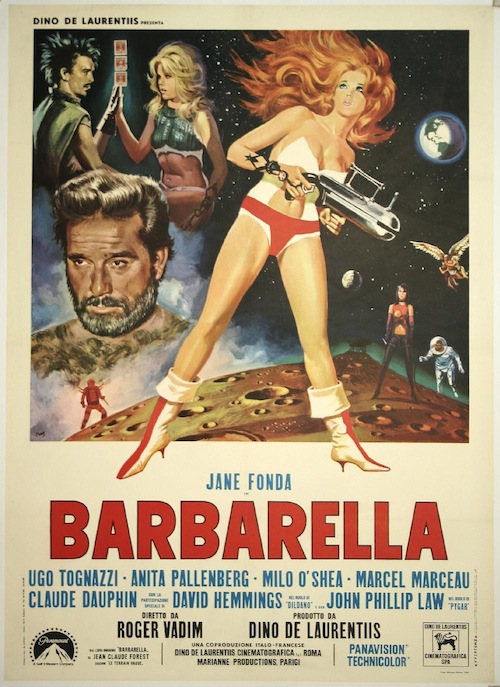
The famous poster by Robert McGinnis.
Aha! If there’s another narrative to the BARBARELLA appeal beyond sex, it’s girl power. The film came at this neat little intersection of the free love ‘60s and the peak of the misogynist spy fantasies like James Bond. There had simply never been a female action hero who freely used and enjoyed sex while saving the day. (Hell, it’s still hard to find a character like that today!) Perhaps this explains why Barbarella became a feminist icon, and a popular cosplay target for over 40 years. It’s common to see Barbarellas walking the floors at comic book shows and sci-fi conventions, and the heroine’s legend is so large today that the film lives under constant threat of remake, with the most recent major attempt fronted by director Robert Rodriguez as a vehicle for Rose McGowan, who he’d already cast once as an ass-kicker in his GRINDHOUSE entry, PLANET TERROR (2007).
Does BARBARELLA deserve its infamy? I finally sat down to watch the film today, and I was kind of amazed with what I found. Despite its legacy in the sexual revolution, BARBARELLA can sometimes be cruel, and other times naïve. After the famous opening strip scene (described in wonderful detail here on this very site), we learn that Fonda’s secret agent is a wide-eyed wonder. A child of a civilization that has evolved beyond violence and pain, she greets the world with simple joy and, when confronted with the bizarre horrors in an “unevolved” part of the galaxy, she simply pushes through and perseveres, using far more optimism than skill. Melanie Magnifique rightly describes Barbarella as “a female protagonist who wants to do the right thing, but is sometimes a little confused about what that thing is.” Fonda’s earnest devotion to her mission is entertaining, even if that mission sometimes devolves into bizarre, disconnected segments. She’s nearly devoured by carnivorous songbirds, for crying out loud.
As for the sex, my adolescent self would have enjoyed Fonda’s matter-of-fact approach to her body and to the sexual beings she encounters. She’s more or less willing to have sex just for the asking, which works both for and against her feminist reputation. On the one hand, the film is full of scenes of sexual aggression or sexual bartering. Sex is a currency that gets Barbarella from place to place, and there’s an unsettling trend towards sexual torture. It’s easy to read the film as misogynist, using Barbarella as a doll to act out aggressive male fantasies. But, on the other hand, there’s something charming and empowering about how Barbarella, after having been introduced to real sex (in the future, evolved beings do it with a pill) by an impossibly masculine hunter, Barbarella blossoms as a sexual being, pursuing sex with the chiseled angel Pygar and showing frustration when a bumbling freedom fighter (the awesome David Hemmings in the film’s best supporting role) wants to do it with the pill.
 Although the film sought mainstream success, BARBARELLA is a movie destined for cult status. Like every good cult flick, there are moments that you simply can’t believe you’re seeing, scenes that should be impossible in a well-budgeted studio film, and yet here they are. This is a film for an audience, if simply so you can turn to the person next to you to share a laugh and one of those “holy shit” looks. This movie should be *ahem* a shared experience, not a solo trip. Even with all the sex, there’s something incredibly innocent about the film, and it serves as a window into a more optimistic, good-natured time. It’s fitting, then, that it’s being hosted at the Plaza this weekend by Blast-Off Burlesque. Burlesque itself is an art form that walks that beautiful line between sweetness and spice, and BARBARELLA is their kind of movie. When asked about the links between burlesque and BARBARELLA, Melanie Magnifique agreed: “It contains many simple theatrical tricks which are used to achieve special effects (we do that a lot).”
Although the film sought mainstream success, BARBARELLA is a movie destined for cult status. Like every good cult flick, there are moments that you simply can’t believe you’re seeing, scenes that should be impossible in a well-budgeted studio film, and yet here they are. This is a film for an audience, if simply so you can turn to the person next to you to share a laugh and one of those “holy shit” looks. This movie should be *ahem* a shared experience, not a solo trip. Even with all the sex, there’s something incredibly innocent about the film, and it serves as a window into a more optimistic, good-natured time. It’s fitting, then, that it’s being hosted at the Plaza this weekend by Blast-Off Burlesque. Burlesque itself is an art form that walks that beautiful line between sweetness and spice, and BARBARELLA is their kind of movie. When asked about the links between burlesque and BARBARELLA, Melanie Magnifique agreed: “It contains many simple theatrical tricks which are used to achieve special effects (we do that a lot).”
“Oh, also, we love to smoke Essence of Man.”
The show starts at 10 pm on Saturday with music, a dance party and complementary signature cocktails, but says Magnifique, “Come early to get your groove on!”
And be sure to read our other Retro Review: Jane Fonda Has No Clothes On: Stripping Down Our Love Affair with Psychedelic ’60s SF Camp Cult Classic BARBARELLA in Time for a Blast-Off Burlesque Taboo-La-La at the Plaza Theatre by Robert Emmett Murphy Jr.
Category: Retro Review | Tags: Andrew Kemp, Anita Pallenberg, Barbarella, Blast-Off Burlesque, cult movies, David Hemmings, death by orgasm, Devil's Cock, Dino di Laurentiis, duran duran, essence of man, excessive machine, Flash Gordon, grindhouse, James Bond, Jane Fonda, John Phillip Law, Klute, Marcel Marceau, Max Shell, Melanie Magnifique, Milo O'Shea, Planet Terror, Plaza Theatre, Pygar, Robert McGinnis, Robert Rodriguez, Roger Vadim, Rose McGowan, sex pistols, Star Wars, Taboo-La-La, The Clash
Posted on:
Jan 16th, 2013 By:
Anya99
 WHITE ZOMBIE (1932); Dir. Victor Halperin; Starring Bela Lugosi, Madge Bellamy, John Harron and Robert Frazer; World premiere Friday, Jan. 18 @ 8:00 p.m. hosted by Prof. Morte (scary details at end of story), and Jan. 25-31; Plaza Theatre; Trailer here.
WHITE ZOMBIE (1932); Dir. Victor Halperin; Starring Bela Lugosi, Madge Bellamy, John Harron and Robert Frazer; World premiere Friday, Jan. 18 @ 8:00 p.m. hosted by Prof. Morte (scary details at end of story), and Jan. 25-31; Plaza Theatre; Trailer here.
By Aleck Bennett
Contributing Writer
Long before George A. Romero’s NIGHT OF THE LIVING DEAD forever redefined “zombie” in the public mind as “undead, flesh-eating ghoul,” the Halperin Brothers first brought the Haitian legend of the zombie to the screen with 1932’s WHITE ZOMBIE.
The movie finds young couple Madeline Short (Madge Bellamy) and Neil Parker (John Harron) reuniting in Haiti to be wed at the plantation of their friend Charles Beaumont (Robert Frazer). Beaumont’s secret love for Madeline drives him to visit local voodoo master Murder Legendre (Bela Lugosi) in order to enlist his help in winning Madeline’s hand. Legendre provides Beaumont with a potion that will transform her into a zombie, robbed of her will and love for Parker. He complies with Legendre’s instructions, but soon finds that the villainous voodoo master has plans of his own for the young beauty.
In 1932, America was in the midst of a newfound fascination with voodoo due to New Orleans’ emergence as a tourist destination. Interest was further fueled by authors such as William Buehler Seabrook. Seabrook was a well-traveled journalist, explorer, occultist and Georgia resident who had gained renown by documenting occult practices across the globe, including some of the only objective contemporaneous reporting on Aleister Crowley. Seabrook’s interest in the occult led him to spend considerable time in Haiti researching voodoo and the Culte des Morts. This adventure resulted in his 1929 book THE MAGIC ISLAND, which introduced the concept of the “zombie” to American audiences.
Producer Edward Halperin and his brother, director Victor Halperin (along with screenwriter Garnett Weston) capitalized on the nation’s interest in voodoo by borrowing liberally from both Seabrook’s work and Kenneth Webb’s 1932 Broadway play, ZOMBIE, and crafted an atmospheric masterpiece. The Halperins enlisted Bela Lugosi, fresh off his success in Universal’s 1931 smash DRACULA. It’s unclear as to Lugosi’s reasons for choosing to immediately follow a major studio hit with a micro-budgeted independent film, but he may have seen it as a way to stretch his creative muscles in a low-risk venture. Although he was paid little for his role (reports vary from $500 to $5000), his co-star Clarence Muse reported that Lugosi rewrote portions of the script, restaged some of the scenes and even directed portions of the film. His personal investment in the end results may be why Lugosi considered WHITE ZOMBIE a favorites among his own movies.
 It could also be because it’s just a damned fine film.
It could also be because it’s just a damned fine film.
The film deftly balances the legendary with the actual. While Legendre’s zombies are the reanimated corpses of Haitian lore (their look provided by Universal’s maestro of makeup, Jack Pierce), the film also depicts his use of a poison that emulates death and results in the victim’s deathlike trance and subsequent subservience to a bokor or sorcerer. Though this method had long been suspected, a pharmacological explanation for the zombie phenomenon wouldn’t be confirmed until ethnobiologist Wade Davis’ explorations into Haiti in the 1980s.
Beyond the film’s knowing mixture of fact and fiction, it benefits from the collaboration of Victor Halperin, cinematographer Arthur Martinelli and music superviser Abe Meyer. Together, they take what may have read on the page as stagebound and stodgy and create a dreamlike vision that mirrors Carl Dreyer’s VAMPYR (also 1932), echoes elements of contemporaneous Universal horrors and anticipates Val Lewton’s exercises in atmosphere and sound design. Constantly inventive staging and camera work—taking place on sets borrowed from DRACULA, FRANKENSTEIN and THE HUNCHBACK OF NOTRE DAME—operate in sync with native drumming, chants, ambient noise, eerie rearrangements of classical works and original music by Xavier Cugat to deliver a palpable sense of creeping death under the oppressive hand of Murder Legendre.
And in the role of Legendre, Lugosi becomes the embodiment of evil itself. No other role—not even Dracula—fully utilizes his mesmeric power and hypnotic presence. From the opening scene, when his eyes are superimposed on the landscape of Haiti, his presence is felt in every frame of film; this is the power of his performance as Murder Legendre. The Halperins attempted to recapture the magic of this film with a sequel, REVOLT OF THE ZOMBIES, but made the mistake of attempting to replace Bela with Dean Jagger. It’s no small wonder that the subsequent film failed.
For years, WHITE ZOMBIE only circulated on washed-out transfers of faded 16mm prints, mastered for public domain VHS and TV broadcast. In 1999, two rare 35mm prints were used to create the restored version released on DVD by the Roan Group. However, those prints were hardly in pristine condition, displaying evident damage and dropped frames.
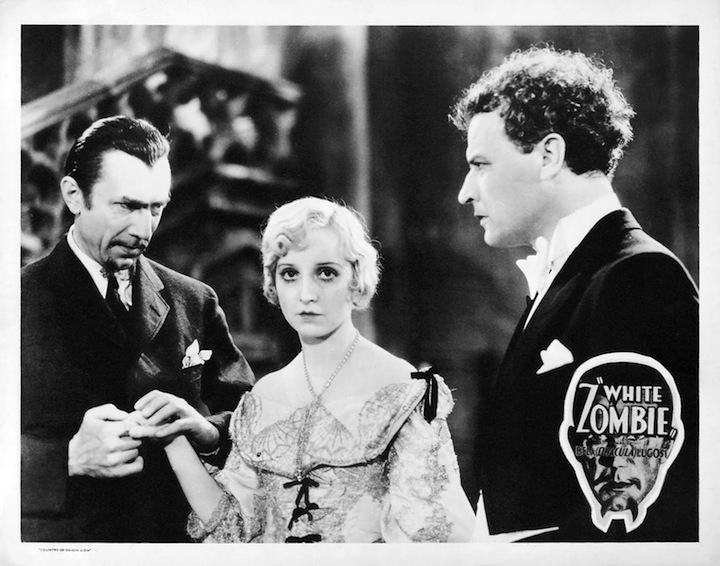
Left to right: Bela Lugosi as voodoo master Legendre, a mesmerized Madge Bellamy and a concerned John Harron in WHITE ZOMBIE (1932).
In recent years, Los Angeles-based Holland Releasing had heard that a previously unknown complete 35mm print was rumored to be in the possession of an aged film collector. Thomas W. Holland (a previous resident of Roswell and Marietta) spoke about the efforts to track down this elusive print and its owner. “I heard a rumor about an old fellow who claimed to have a superb, original 35mm print and that began a worldwide search to find this aging, eccentric film lover and convince him to let us acquire the film for a full restoration. People think I’m joking when I say I had to go through a friend of a friend of a friend to contact this man.” When the print was found, Holland was stunned at its overall condition. “It must have been removed from theatrical service early on, or been set aside as a special studio print.” The Holland Releasing group then set about restoring the film.
AlgoSoft-Tech USA, based in Bishop, Georgia, was hired to return WHITE ZOMBIE’s image quality to its original standards. AlgoSoft’s president, Dr. Inna Kozlov, a famed mathematician in her native Russia, took on the project with great excitement. “We arranged to have the vintage 35mm print scanned, frame-by-frame, at a very high resolution so as not to lose any information.” From that point, Dr. Koslov and her technology developer, Dr. Alexander Petukhov wrote customized software to correct any imperfections in each frame. “Our goal was to return the film’s visuals to how they looked in 1932, the way a vintage carbon arc light source would have glistened through a silver nitrate print of the era.”
Another Atlanta firm, Crawford Media Services, was chosen to do the final re-assembly of the motion picture which included intensely detailed color-correction. “Being a black-and-white film, WHITE ZOMBIE required far more expertise and patience than a typical color feature to get the light levels correct,” says producer Holland. “This film is a gothic masterpiece, and we wanted it to look exactly the way it did when audiences first saw it.”
 Once the Georgia image work was completed, the master was sent to Chace Audio by Deluxe in Burbank, California. Using a variety of sources, Chace remastered the film’s faded audio tracks to restore the sound to match the quality of the restored image. “Early sound films had a tremendous amount of inherent hiss, clicks and pops,” Holland says, “but Chace was able to give us a new audio track that greatly reduced this. We weren’t looking to make a hi-fi version of the WHITE ZOMBIE track, just a cleaner, clearer representation of how the movie originally sounded in theaters of the ’30s.”
Once the Georgia image work was completed, the master was sent to Chace Audio by Deluxe in Burbank, California. Using a variety of sources, Chace remastered the film’s faded audio tracks to restore the sound to match the quality of the restored image. “Early sound films had a tremendous amount of inherent hiss, clicks and pops,” Holland says, “but Chace was able to give us a new audio track that greatly reduced this. We weren’t looking to make a hi-fi version of the WHITE ZOMBIE track, just a cleaner, clearer representation of how the movie originally sounded in theaters of the ’30s.”
Of course, any restoration invites an amount of controversy, and WHITE ZOMBIE is no exception to this rule. The Holland restoration, which has been licensed for use on an upcoming DVD and Blu-Ray release by Kino/Fox Lorber, is already attracting its share of debate from advance reviews. (The release offers two viewing options for comparison: the Holland restoration and a “raw” transfer of the print used prior to AlgoSoft’s restorative work.) However, without actually being able to see an arc light-projected silver nitrate print of WHITE ZOMBIE, it’s impossible to say that the Holland restoration is an inaccurate representation of how the film looked in 1932.
What is most exciting, though, is the chance to see WHITE ZOMBIE on the big screen once again as the restoration makes its world premiere at the Plaza Theatre. The Plaza is making this night a grand event. Hosted by Professor Morte of the Silver Scream Spookshow (aka Shane Morton) and Blake Myers (Atlanta effects artist, filmmaker, Buried Alive Film Festival programmer and ATLRetro Kool Kat, whose credits include THE WALKING DEAD and V/H/S), the film will be preceded by the vintage Betty Boop cartoon “Is My Palm Read?” and followed by the 1932 short subject “An Intimate Interview with Bela Lugosi.” Following the filmed entertainment, the team behind WHITE ZOMBIE’s restoration will take part in a question-and-answer session. And attendees will have a chance to win a lifetime all-inclusive ticket to the Plaza, original Plaza seats and T-shirts and monster masks from event sponsor Atlanta Zombie Apocalypse.
Following its premiere on January 18, the film will be showing at the Plaza for a full week, running from January 25-31, and will be shown on a one-time-only basis in theaters across the Unites States and Canada. But you can be there first and see WHITE ZOMBIE brought back to life at its world premiere in Atlanta.
Aleck Bennett is a writer, blogger, pug warden, pop culture enthusiast, raconteur and bon vivant from the greater Atlanta area. Visit his blog at doctorsardonicus.wordpress.com
Category: Retro Review | Tags: 16mm, 35mm, Abe Meyer, Aleck Bennett, Aleister Crowley, Alexander Petukhov, AlgoSoft-Tech, arc light, Arthur Martinelli, Atlanta Zombie Apocalypse, Bela Lugosi, Betty Boop, Blake Myers, Carl Dreyer, Chace Audio by Deluxe, Charles Beaumont, Clarence Muse, Crawford Media, cult movies, Culte des Morts, Dean Jagger, Doctor Sardonicus, Dracula, Edward Halperin, Frankenstein, friday, Garnett Weston, George Romero, Haiti, Halperin brothers, Holland Releasing, horror movies, Hunchback of Notre Dame, Inna Kozlov, Intimate Interview with Bela Lugosi, Is My Palm Read, Jack Pierce, jan. 18, john harron, Kenneth Webb, Kino/Fox Lorber, madge bellamy, Murder Legendre, night of the living dead, Plaza Theatre, Professor Morte, restoration, restored, Revolt of the Zombies, Roan Group, robert frazer, Silver Scream Spookshow, The Magic Island, Thomas W Holland, Tom Holland, Universal, V/H/S, Val Lewton, Vampyr, victor halperin, voodoo, Wade Davis, Walking Dead, white zombie, William Buehler Seabrook, world premiere, Xavier Cugat, zombies
Posted on:
Nov 27th, 2012 By:
Anya99
 LADY TERMINATOR (1988); Dir: H. Tjut Djalil (aka Jalil Jackson); Starring: Barbara Anne Constable, Christopher J. Hart and Claudia Angelique Rademaker; Thurs. Nov 29, 9 p.m.; Cinefest Film Theatre; $5 (free for GSU faculty, students and staff with Panther ID); Trailer here.
LADY TERMINATOR (1988); Dir: H. Tjut Djalil (aka Jalil Jackson); Starring: Barbara Anne Constable, Christopher J. Hart and Claudia Angelique Rademaker; Thurs. Nov 29, 9 p.m.; Cinefest Film Theatre; $5 (free for GSU faculty, students and staff with Panther ID); Trailer here.
By Aleck Bennett
Contributing Writer
The last Thursday of every month brings something almost unexplainable to Cinefest Film Theare…something that approaches that fine line between “good” and “bad” and blows it to kingdom come.
Science fiction author Theodore Sturgeon once postulated something that has since become commonly known as “Sturgeon’s Law”: 90 percent of everything is crap. Few take this law to its logical conclusion, though: if 10 percent of everything is great, it stands to reason that 10 percent of the crap left over is really great crap.
Ladies and gentlemen, the 1988 Indonesian epic LADY TERMINATOR is some really great crap.
It’s hard to go wrong with any movie that opens with death by hoo-hah. I mean, that’s just science fact. By presenting you with this event right up front, LADY TERMINATOR is letting you know that anything can—and likely will—happen at any time. Before the opening credits hit, we not only see what happens to those who attempt to bed the woman known as the “South Sea Queen” and not satisfy her, we find out that the one man who does succeed at the task pulls an eel out of the mysterious woman’s…area…and turns said eel into a knife. This angers the temptress, which seems reasonable. She says that she will return in 100 years to seek revenge on his great-granddaughter, and then flees into the oceans’ depths to join with the forces of evil.
Like you do.
Fast forward 100 years, and a feisty young scientist named Tania (key quote: “I’m not a lady, I’m an anthropologist!”) comes to town to research the legend of the South Sea Queen. She takes a boat out to where the Queen’s castle supposedly collapsed into the ocean (it’s nowhere near shore, but why let this story be bound by little things like geography?), dives down to see if she can find the ruins, is magically transported to a bed in the middle of nowhere and tied down by sentient scarves, and the mysterious eel from earlier takes up new residence in a new…area. She emerges from the ocean possessed by the spirit of the South Sea Queen yet acting like Arnold Schwarzenegger in THE TERMINATOR, boinks a few random jerks, and proceeds to get on with the job of seeking vengeance by pursuing that previously mentioned granddaughter (who, naturally, happens to be a pop star).
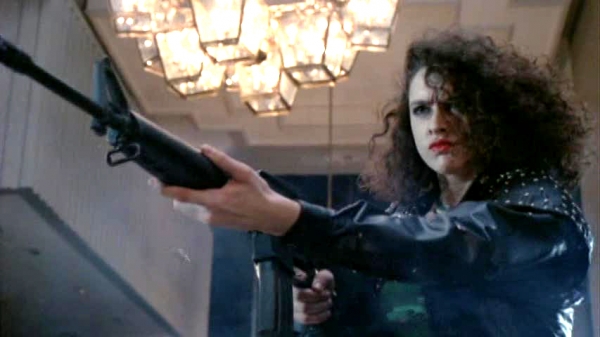
Barbara Anne Constable is LADY TERMINATOR. Studio Entertainment, 1989.
From that point onward, the film is a non-stop barrage of gunfire, vehicles exploding, sex, blood, nudity, bad pop music, sub-John Carpenter synthesizer score, atrocious dubbing, ridiculous dialogue, popped-collar Polo shirts, inexplicable decision-making, goofy romance, jewelry mix-ups, uncalled-for hotel room eye surgery…and I think that the narrator from the TALES FROM THE DARKSIDE television series shows up. We’re never exactly told why the titular Lady Terminator acts like a cyborg, nor why she can’t be killed, nor why she can shoot laser beams out of her eyes and create electrical energy with her hands. Possession is a mysterious thing. Maybe it’s got something to do with those eels. Maybe they’re electric eels.
It’s hard to give this film any kind of critical analysis or review. It escapes logical exploration. It exists in a place beyond human reasoning. It stubbornly dares you to justify itself. And while it’s true that few movies have so little reason to exist, fewer deliver on the goods the way that LADY TERMINATOR does in its own remarkably wrongheaded way. It manages to effortlessly accomplish what any number of Troma Entertainment productions go out of their way to attempt, and without any of the “hey, we’re trying to make a bad movie here!” winking that you get from Troma’s output. It may not be accomplished on any level, objectively speaking, but it’s never boring in the least. It’s fun. It’s insanely entertaining. And, really, shouldn’t that be the standard by which it’s judged?
LADY TERMINATOR is crap. But it’s really great crap.
Aleck Bennett is a writer, blogger, pug warden, pop culture enthusiast, raconteur and bon vivant from the greater Atlanta area. Visit his blog at doctorsardonicus.wordpress.com
Category: Retro Review | Tags: actions movies, Aleck Bennett, Arnold Schwarzenegger, B movie, Barbara Anne Constable, Christopher J Hart, cinefest, Claudia Angelique Rademaker, crap, cult movies, electric eel, H Tjut Djalil, Indonesian movies, Jalil Jackson, Lady Terminator, retro review, South Sea Queen, Tales from the Darkside, Tania, Theodore Sturgeon, Thursday, Troma
Posted on:
Nov 20th, 2012 By:
Anya99
 THE ROAD WARRIOR (1981); Dir: George Miller; Starring Mel Gibson, Bruce Spence, Kjell Nilsson; Wed. Nov. 21 9:30 p.m.; Plaza Theatre; Presented by Astrodog; trailer here.
THE ROAD WARRIOR (1981); Dir: George Miller; Starring Mel Gibson, Bruce Spence, Kjell Nilsson; Wed. Nov. 21 9:30 p.m.; Plaza Theatre; Presented by Astrodog; trailer here.
By Andrew Kemp
Contributing Writer
George Miller’s THE ROAD WARRIOR is the STAR WARS of the post-apocalypse. The film didn’t invent the genre, but it seemed to perfect it and codify it for an entire generation of fans while simultaneously transforming Mel Gibson into a household name, and it’s returning to the big screen for one night only at the Plaza Theatre on November 21 at 9:30 p.m., presented by Astrodog.
One man alone in a wasteland. A growling convoy of modified trucks driven by thieves and thugs. A shantytown built from spare parts and spare people. We’ve seen these elements before, clichés of the post-apocalypse. Whenever we imagine a world-killing event, we tend to assume that society will give it about a week before we all start eating each other. It’s one of the oldest “what ifs” we have. What if tomorrow there was nothing left of the world but ruins, need and violent men?
But THE ROAD WARRIOR uses these familiar elements to create an action movie that transcends the grim parameters of its subject matter, making the end of the world thrilling, exciting, and even… fun. It’s the apocalypse-as-theme-park, but it completely, totally works, and although the film falls squarely in the middle of a larger franchise—the MAD MAX series—it’s easily the best of the bunch.
Gibson stars as Max, a lone warrior simply trying to survive in the aftermath of an unnamed apocalypse. Max’s world has been reduced to a barren desert (and one that looks awfully similar to the Australian outback), and vehicles have become as essential to survival as food and water. That means, naturally, gasoline (a suddenly non-renewable resource) is more precious than gold. In search of gas, Max enters an uneasy alliance with a rusty settlement of survivors, but he faces a tough choice when the town is besieged by brutal bandits led by the Lord Humongous (Nilsson). Will he abandon the town or put his life on the line to defend them? Hint: running away wouldn’t make for much of a movie.
It’s tough to look at Gibson today without getting tangled up in the headlines and scandals that have effectively ended his Hollywood career. It’s pretty clear at this point that Gibson has morphed into a fairly despicable person behind the camera, but his presence in front of the camera is impossible to deny. THE ROAD WARRIOR leaves no room for Max’s backstory, no tender moments to open up to the people around him. He’s nearly silent, a wandering ronin in the wrong place and time, but Gibson’s haunted eyes tell all the story you need. You can feel Max’s loneliness and pain even during the moments where he’s flint-hard. THE ROAD WARRIOR is a movie that doesn’t need its predecessor, but if you know that Max was once a cop and that he lost his family to thugs like Humongous, the extra layers start popping.
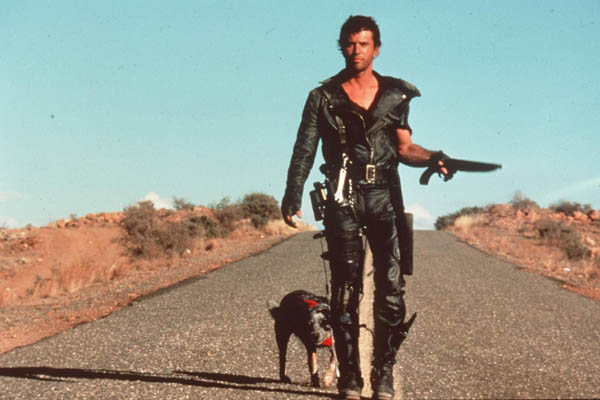
Mel Gibson as Mad Max in THE ROAD WARRIOR. Warner Brothers, 1981.
THE ROAD WARRIOR is also one of the crown jewels of raging car movies, a cinematic soulmate to films like DEATH RACE 2000 (1975) or VANISHING POINT (1971). George Miller arrived on the scene during the peak of “Ozploitation,” a golden age of Australian trash cinema that ran throughout the 1970s and ’80s and produced a slew of genre classics, from WAKE IN FRIGHT (1971), to LONG WEEKEND (1978) and DEAD END DRIVE-IN (1986). Miller was playing to an Aussie audience that knew their way around a car chase, and so he doesn’t skimp on the action, stuffing the film full of crunching metal, roaring engines, and cackling villains. The result is entertaining and often mythic. Stripped of its setting, THE ROAD WARRIOR is still a film about one man struggling against unbeatable odds for no other reason than it’s the right thing to do. The timelessness of the story has helped the movie age very well, and, if anything, it’s even more relevant today. Produced in the wake of the gas shortages and transportation nightmares of the 1970s, the film feels especially timely in a world of $4 a gallon gas and feasible projections that say we’ve either neared or reached (and passed) the peak of our oil production. The world of the future may belong to the likes of Humongous.
THE ROAD WARRIOR improved on its less-polished, more visceral predecessor MAD MAX (1979), but the series took a nose dive in the third film, MAD MAX BEYOND THUNDERDOME (1985). After that, Miller’s career went off into a variety of directions. Most recently, he’s been crafting thoughtful (if not entirely successful) fantasy films for children, producing Oscar-nominee BABE (1995) and directing its culty sequel, BABE: PIG IN THE CITY (1998) and both HAPPY FEET (2006) and HAPPY FEET TWO (2011). But that engine you’re hearing is the sound of that changing. Miller has been deep in production on the fourth film in his series, MAD MAX: FURY ROAD, for the last couple of years, replacing Gibson with the younger and suddenly very marketable Tom Hardy. Although the new film isn’t considered a remake or a reboot, it will still serve to introduce the franchise to a new generation of fans. For those who can’t wait that long, THE ROAD WARRIOR was born for the big screen.
Category: Retro Review | Tags: Andrew Kemp, apocalypse, Astrodog, Australian movies, Babe, Babe: Pig in the City, Bruce Spence, car movies, chase, cult movies, Dead End Drive-In, Death Race 2000, Fury Road, gasoline, George Miller, happy Feet, Humongous, Kjell Nilsson, Long Weekend, Mad Max, Mad Max Beyond Thunderdome, Mel Gibson, Plaza Theatre, retro review, Road Warrior, Star Wars, Tom Hardy, Vanishing Point, Wake in Fright
Posted on:
Nov 8th, 2012 By:
Anya99
 SUSPIRIA (1977); Dir: Dario Argento; Starring Jessica Harper, Stefania Casini, Joan Bennett; Sat. Nov. 10 9:30 p.m.; Plaza Theatre; Presented by Splatter Cinema for the Buried Alive Film Fest; trailer here.
SUSPIRIA (1977); Dir: Dario Argento; Starring Jessica Harper, Stefania Casini, Joan Bennett; Sat. Nov. 10 9:30 p.m.; Plaza Theatre; Presented by Splatter Cinema for the Buried Alive Film Fest; trailer here.
By Andrew Kemp
Contributing Writer
The fine folks over at Splatter Cinema are offering gorehounds and the gore-curious a chance to see SUSPIRIA on the screen this coming weekend as the grand finale of the Buried Alive Film Fest (Read our full festival preview here). They’re advertising this screening as a “Special Restored Edition” which suggests that this beautiful film will be presented without all the marks, scratches and chemical bleeds that might get in the way of the full SUSPIRIA experience. If you’re going, be sure to arrive on time, as SUSPIRIA also sports one of the best taglines in movie history: “The only thing more terrifying than the last 12 minutes are the first 92.”
For hardcore horror fans, SUSPIRIA hardly needs an introduction. For many, just the first few notes of the main musical theme are enough to send them into vivid memories of their favorite scene, the most gruesome death, or the way they felt when they finally saw that famous last reel. “Cult” is a term that gets thrown around too easily with genre flicks, but SUSPIRIA is one of those movies that earns the title. There’s a church of the converted for this film. Critics overwhelmingly support the movie, and some (such as The Village Voice) even say it’s one of the greatest movies of the entire 20th century. That’s quite a lofty position for a film that’s more about mood than plot, lives on extraordinary violence and willingly, gleefully makes little sense.
What story there is revolves around Suzy (Jessica Harper), an American ballet student who arrives in Germany to attend a prestigious dance academy, only to gradually discover that the school is infested with a coven of witches. And while “a school full of witches” might invoke pleasant thoughts of Potions Class and mail-by-owl, Hogwarts this ain’t. These witches, led by headmistress Madame Blanc (Joan Bennett, DARK SHADOWS), conjure dark forces and engage in sadistic rituals, pursuing bloody, prolonged murder for anyone who gets in the way of their sinister, yet oddly vague schemes.
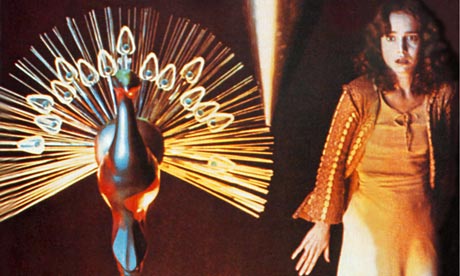
Jessica Harper in SUSPIRIA (1977).
SUSPIRIA (the title translates loosely into “Sigh”) is one of the best-known titles from Italian horror maestro Dario Argento and helped to cap the short, intense heyday of the Italian giallo picture. The history of Italian cinema is built around trends, with hordes of opportunistic producers chasing any large success by flooding the cinemas with lookalike content. Just as the smash hits A FISTFUL OF DOLLARS (1964) and DJANGO (1966) launched a tidal wave of violent, sweaty (spaghetti) Italian westerns in the 1960s, the 1970s belonged to the Italian thrillers and early slasher films. Originally spinning off from the works of Alfred Hitchcock—the movie usually considered the first giallo, Mario Bava’s THE GIRL WHO KNEW TOO MUCH (1963), was an obvious and unlicensed Hitchcock homage—the giallo genre increased the intensity and cheapness of the thrills, placing their usually-female protagonists in the path of knife-crazed killers, and combining the elements of a whodunit mystery with murder scenes extended beyond belief and buckets upon buckets of blood. Argento made his international name in the genre, and the artistic ambition and style of his films, such as THE BIRD WITH THE CRYSTAL PLUMAGE (1970), inspired a rash of imitators and launched giallo’s peak in the early 1970s, when it extended into all areas of Italian culture, from film to music and literature. In fact, the term giallo itself means “yellow” and refers to the cheap, yellow covers of the typical Italian pulp slasher novel.
By the time Argento made SUSPIRIA, the giallo picture’s moment was nearly over, and the genre had drifted into some very weird territory by embracing the supernatural. Giallo had always favored style over story. Directors like Argento and Bava realized that the plots of their films were usually too silly or too convoluted to hold an audience, and so they treated the films as exercises in image and technique. For SUSPIRIA, Argento took this philosophy to its logical end, drenching the movie in vivid, saturated colors and horrific, grotesque gore. These elements, combined with the odd twists and turns of its story, give SUSPIRIA a dreamlike quality, like a nightmare you’re only half-aware isn’t real. These elements steer SUSPIRIA away from its exploitation roots and into a cinema of the surreal, a deeply affecting and harrowing journey through a landscape that should make sense, but doesn’t.
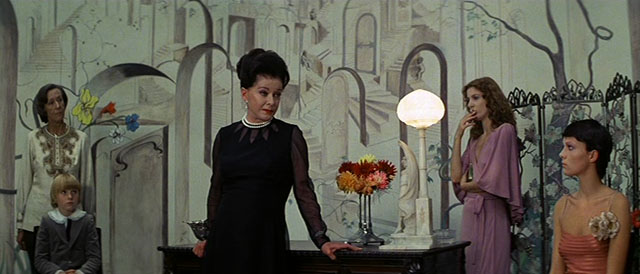
Joan Bennett as Madame Blanc in SUSPIRIA (1977)
Backing up this feeling is the film’s famous score, created by the prog rock group Goblin. The infectious, haunting music is as inseparable from the mood and effect of SUSPIRIA as “Tubular Bells” is from THE EXORCIST (1973) or John Carpenter’s main theme from HALLOWEEN (1978), itself heavily inspired by Argento’s work.
SUSPIRIA is an entertaining film, but it’s also an experiment into the effects of extreme cinema on something as primal as the horror movie. Unlike the blunt, mostly artless slasher films it inspired in the states, SUSPIRIA remains one of the prime examples—perhaps THE prime example—of the horror movie as art. There’s been talk of a Hollywood remake for the last several years, but it seems to stall at least in part because the act of remaking a film is largely about the story and the premise, and what makes SUSPIRIA so noteworthy is everything else.
Andrew Kemp is a screenwriter and game writer who started talking about movies in 1984 and got stuck that way. He writes at www.thehollywoodprojects.com and hosts a bimonthly screening series of classic films at theaters around Atlanta.
Category: Tis the Season To Be... | Tags: bird with the crystal plumage, Buried Alive Film Fest, coven, cult movies, Dario Argento, Dark Shadows, giallo, Goblin, gore, horror, Italian horror, Italian movies, Jessica Harper, Joan Bennett, Mario Bava, Plaza Theatre, pulp, restored edition, slasher, spaghetti Western, Splatter Cinema, Stefania Casina, Suspiria, the girl who knew too much, Village Voice, witches





































